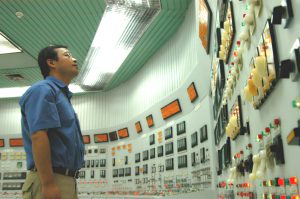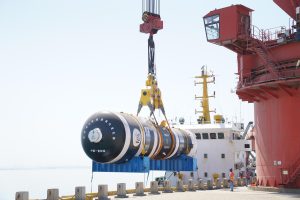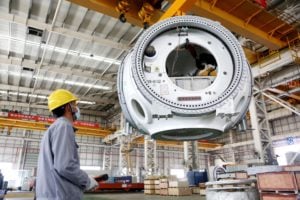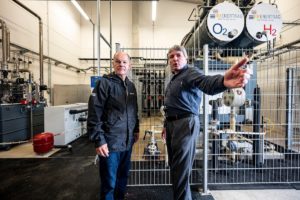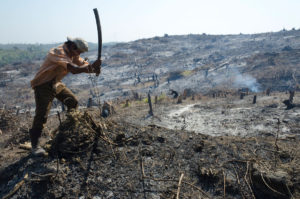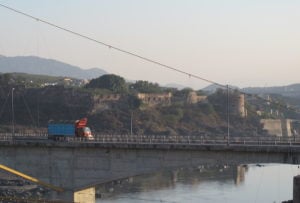There seems to be at least one thing everyone can agree on when it comes to nuclear power: dealing with the industry’s dangerous radioactive waste is an urgent global matter.
There is an enormous backlog of radioactive residues from nuclear reactors, known as high-level waste, in need of safe and permanent disposal. This presents a major challenge and inhibits social acceptance of the energy source at a time when the industry is presenting itself as essential to addressing the climate crisis, as well as energy security in a changing geopolitical landscape.
Though complex, nascent and resource-intensive, the development of deep geological storage sites for spent nuclear fuel and other wastes is currently seen by many as the future gold standard for disposal – and a boon to the industry in those countries that can boast progress in such approaches.
Finland, for example, is using the construction of ONKALO, a first-of-its-kind deep geological disposal site due to enter operation in 2025, as the basis for dramatically increasing the share of nuclear power in its energy mix. It claims these plans are responsible because it is sufficiently tackling one of the industry’s biggest challenges.
Lack of progress on developing a geological repository impedes… nuclear energy as part of a zero-carbon futureUS Nuclear Waste Technical Review Board, April 2021
By contrast, the stalemate on creating such disposal sites in the United States – for now the world’s largest producer of nuclear energy – is hindering a further build-out of nuclear power, according to the nation’s panel on nuclear waste issues.
“The lack of progress on developing and operating a geological repository… impedes the associated potential benefits of having nuclear energy as part of a zero-carbon future for mitigation of climate change,” the US Nuclear Waste Technical Review Board wrote to Congress in April 2021.
While the promise of new technical solutions to the nuclear waste problem remains on the horizon, emerging issues, such as modern power plants producing even more radioactive waste, are further complicating storage and disposal prospects.
A push to expand nuclear power
Some consider nuclear power essential for decarbonising economies due to a few key factors.
Firstly, nuclear power plants’ emissions of greenhouse gases and other air pollutants are close to zero during the operating phase. Secondly, they provide baseload generation of electricity that operates when intermittent renewable energy sources like solar and wind are unable to. Finally, they support, rather than compete with, renewable energy sources, because the plants are uniquely adaptable to changing demand load.
The International Atomic Energy Association (IAEA), the global agency supporting and advocating nuclear power, recently emphasised the last point using 2020 data from nuclear plants, when electricity demand fluctuated more than usual due to the pandemic.
“Flexible nuclear power plant operation – or, in some cases, complete short-term shutdowns – supported grid operator needs and demonstrated nuclear power’s ability to integrate into sustainable energy systems of the future,” the agency said in a report published in June 2021.
The IAEA predicts that nuclear generating capacity could double to 792 gigawatts by 2050, compared to 393 gigawatts in 2020, though this high-end scenario would require significant actions in order to be realised. Disposal, however, is an issue for the here and now, and one that will only grow more urgent, whether capacity reaches low-end or high-end projections.
Geological disposal remains gold standard
The international consensus is that high-level radioactive waste should be finally disposed of deep underground, in geological sites where it can remain sealed off from the surface and atmosphere well into the distant future, since spent nuclear fuel remains dangerously radioactive for hundreds of thousands of years.
Finland is the first country to have such a facility under construction which, as mentioned, is due to start storing waste in 2025, with trial runs beginning in 2023, according to Posiva, the company tasked by the Finnish government with handling final nuclear waste disposal.
Situated near the Olkiluoto nuclear power plant on Finland’s west coast, the ONKALO repository will be built to a depth of 400 to 430 metres into the bedrock. The project utilises a method of disposal developed in Sweden, called KBS-3V, which employs a multiple barrier system currently seen as the international standard.
The process of disposal begins with individual tubes of waste being collected into a larger assembly. Groups of these assemblies are then placed into cast iron canisters with a 5cm-thick copper exterior – to protect the inner from corrosion – and lowered deep into the underground portion of the facility. There, the canisters are moved to a tunnelled area, where they are placed vertically into individually drilled cavities in the bedrock, and surrounded by bentonite clay; this type of clay expands when exposed to water, thus further sealing the canisters in place. Once the area beneath each tunnel has reached capacity, they are backfilled with bentonite clay and sealed with concrete.
Much of this activity is to be carried out using remote-controlled equipment designed for the purpose.
Finland’s pioneering facility will be closely watched as a number of other countries progress in their own efforts towards geological disposal.
On 27 January, the Swedish government approved a plan from the Swedish Nuclear Fuel and Waste Management Company to build a final geological disposal site in Forsmark, 140km north of Stockholm, and the site of a nuclear power plant. Building permits will need to be issued before construction can begin, but the site reportedly has official approval of the impacted municipalities.
In France, the Industrial Centre for Geological Disposal, or Cigeo, is a deep geological disposal facility proposed near the quiet northeastern village of Bure. The project is currently undergoing the second phase of public consultations, but has faced fierce opposition from anti-nuclear protestors. The project has been under consideration for 30 years, according to Andra, the national agency for radioactive waste management, and construction is currently slated for 2025.
Elsewhere, the United Kingdom, Canada and Switzerland are each in their final phases of site selection – a process dependent in part on public consultation and social acceptance.
Consent-based processes
Government and private sector efforts to engage local municipalities in consent-based siting processes focus on gaining the agreement of residents surrounding a proposed radioactive waste facility. Ideally, the process includes attempts by the government to be transparent, allow communities to weigh the potential opportunities and the risks of hosting such a site, and treat all people fairly.
Engaging the public “requires substantial amounts of time and the right skill sets”, officials and experts from Canada, Finland and Sweden told the US Government Accounting Office as part of a September 2021 report on nuclear waste, prepared for the country’s congress. Canada spent nearly 20 years, Finland 17 years and Sweden over 30 years in educating and engaging with the public, prior to selecting a permanent geological storage site, the report details.
In countries where consent-based processes are not a requirement, progress on geological disposal is being made – though the current timelines are not altogether different for reaching actual operation of disposal sites.
In 2021, China broke ground on an underground laboratory in Gansu province that scientists will use to study whether the site is suitable for the geological disposal of spent nuclear fuel. The lab will be situated 560 metres below the Gobi desert in granite bedrock. If the site is deemed appropriate following testing, the complex could be built in the 2040s and begin operating by 2050.
Meanwhile Russia is also currently constructing an underground research laboratory for similar purposes at a site it has preliminarily deemed suitable for geological storage near the Siberian city of Krasnoyarsk, in the centre of the country.

Alternatives to disposal
Given the time and cost required for construction, and the extreme complexity of geological disposal, some countries are pursuing medium-term solutions known as consolidated interim storage.
These large interim waste facilities are being designed to operate for many decades until geologic disposal becomes more widely available, while also concentrating storage to alleviate the risks associated with high-level waste being spread across numerous sites. Interim sites would have advanced capabilities and technologies for safely storing casks of waste. They would also be sited in areas considered to be at lower risk than the reactor sites where waste is usually held, away from coastlines and in geologically inactive, remote locations.
The United States is home to enormous volumes of spent nuclear fuel – 86,000 tonnes as of 2019 – currently in storage at nuclear power plants. Two private interim storage projects for spent nuclear fuel are being pursued in the country: Holtec’s HI-STORE facility in New Mexico, and Interim Storage Partners’ project in Texas. However, the country’s continuing lack of progress on a final disposal solution could preclude social acceptance of the interim sites.
“States will likely be more hesitant to accept a consolidated interim facility on their land, worrying that ‘interim’ will become long term if there is no final disposal site,” Matt Bowen of the Columbia University Center on Global Energy Policy wrote in January.
Storage and disposal safety concerns
A key emerging issue is the higher levels of radioactivity in contemporary fuels and whether this poses greater risks than legacy fuel.
The average amount of thermal energy generated per unit of fuel has increased from the early days of nuclear reactor operation, resulting in a higher “burnup” of spent nuclear fuel. Higher burnup reduces fuel costs for the industry, but it results in waste that is more radioactive and releases more heat as it decays than lower burnup fuels, as a July 2021 report to the US Congress by the US Nuclear Waste Technical Review Board explains.
“Extensive research on low burnup fuel has provided confidence that it can be stored for extended periods and transported,” the panel’s report says, but stresses that is not the case with high burnup fuels.
Changes to the chemical and physical characteristics of the fuel and its fuel rod assemblies at higher burnup levels are not well understood, according to the report. These different characteristics could increase corrosion and embrittlement of the cladding of storage casks, increase pressure build-up inside the cask or canister, and create other changes that could be particularly concerning during storage, transportation and disposal.
Another key outstanding question is the potentially serious risks posed by the possible need for repackaging waste that has sat in canisters for decades, for transportation or insertion into a geological disposal site.
The momentum toward a new era of nuclear energy is predicated in part on government and industry claims that new technological solutions to nuclear waste are forthcoming. But challenges remain in their realisation at the necessary scale. It is impossible to minimise the real and persistent challenges of existing and future radioactive waste management, which will ultimately shape the outlook of the industry moving forward.

